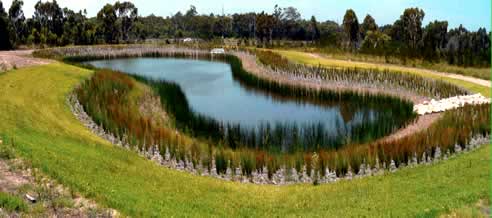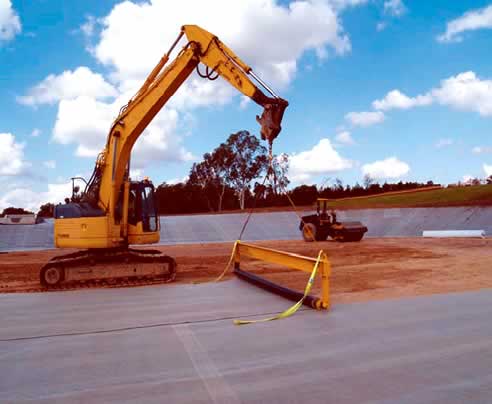Dam and pond lining from Polyfabrics Australia using Bentoliner CBL

Water Proofing Properties of a Plastic Liner with the ease of installation of
a Geosynthetic Clay Liner.
Bentoliner®CBL is a reinforced GCL consisting of a layer of sodium bentonite between two
geotextiles, which are needle punched together and laminated to a flexible membrane liner.
The Bentoliner® CBL has a coefficent of permeability k=5 x 10-12m/sec, and is comparable with
Plastic liners.
Bentoliner® CBL's are highly recommended in:
- Pond and dam application when exposed to high hydraulic heads.
- Applications were GCL is exposed to wetting and drying cycles.
- Applications were GCL is placed against saline soils such as coastal use.
Other applications includes base lining of landfills; as part of the leachate detection and
leachate collection system; landfill capping incorporating a root control system; cut off walls;
etc.
Site Specific Subgrade Preparation
In all site areas to be used, the surface should be cleared of all vegetation, debris, large
rocks (>20mm diameter), and other foreign materials. The subgrade should be graded and compacted
in accordance with the Civil Works specifications, but in any event, should be compacted to at
least 90 per cent of Modified Proctor maximum dry density (ASTM D1557) or such that installation
equipment or other construction vehicles that traffic the area of deployment do not cause significant
rutting.
In Summary
- Grade and compact existing soil; or
- Fill voids by placing 50mm to 75mm leveling layer of fine soil; or
- Install cushioning geotextile.
Deployment
The roll of Bentoliner® is supported during its deployment so that the fabric designated as the
upper surface faces out, away from the installation vehicle (refer to installation guidelines). The
free end of the roll can then be secured (installers standing on edge) and the vehicle supporting
the roll can slowly back away, deploying the Bentoliner® as it moves. Alternatively, the free end
can be manually pulled across an area to be lined by the installation crew while the equipment simply
suspends the roll. Bentoliner® should be covered by a minimum thickness of 300 mm of approved soil or
gravel at the end of the construction day.
Seaming and Joining
Bentoliner seams are constructed by overlapping adjacent panel edges and ends. Care should be taken
to ensure that the overlap zone is not contaminated with loose soil or other debris. Bentoliner® RCGCL
(GCL plus HDPE membrane) has no Supergroove® , bentonite in the form of granules (0.4kg/m) or premix
paste is used on all overlaps. Panels of Bentoliner® should be joined as follows:
- Adjacent panels are overlapped 300 mm -600mm along the side joints, and 600 mm at end joints;
- Seams at the end of panels should be shingled in the direction of the grade to prevent the potential
runoff flow to enter the overlap zone.
Good Deployment Practices
- Deployment should always be from the highest point to the lowest to allow water to drain quickly without
affecting the GCL.
- On slopes, deployment should be down, not across the slope;
- Bentoliner® should be kept as clean as possible at all times up to and including the time of placement
of the next layer of material covering them.
- Edges of exposed sheets should be weighed down with sand bags to prevent uplift in high wind and
infiltration of runoff water.
- GCL panels should be installed in a relaxed condition, and be free of wrinkles and folds.
Anchorage
Bentoliner GCL is typically anchored in a trench around the perimeter of the containment basin to provide
the required pullout resistance. The size and shape of the trench, as well as the appropriate backfill
procedures should be in accordance with the project drawings and specifications. Bentoliner® should be
placed in the trench extending down the inside wall face and along the entire trench floor, secured by
the controlled placement and compaction of backfill into the trench prior to placing cover soil on the slopes.

|





 Geogrid Subgrade Soil Stabilisation from
Geogrid Subgrade Soil Stabilisation from Sustainable Erosion Control &
Sustainable Erosion Control & Rail Drainage Remediation with
Rail Drainage Remediation with Vandal-proof Sand Containers & Erosion
Vandal-proof Sand Containers & Erosion Multi-residential Basement Strip
Multi-residential Basement Strip Geogrids for Subgrade Stabilisation from
Geogrids for Subgrade Stabilisation from Geogrid for High-Strength Railway
Geogrid for High-Strength Railway Geosynthetics for Asphalt Reinforcement
Geosynthetics for Asphalt Reinforcement Geosynthetic Clay Liner | Polyfabrics
Geosynthetic Clay Liner | Polyfabrics Expandable Cellular Confinement System |
Expandable Cellular Confinement System | Turf Reinforcement Mat | Polyfabrics
Turf Reinforcement Mat | Polyfabrics Porous Paving Soak™ Thru |
Porous Paving Soak™ Thru | Sub Soil Drainage Pipes | Polyfabrics
Sub Soil Drainage Pipes | Polyfabrics Biodegradable Erosion Control Mats |
Biodegradable Erosion Control Mats | Silt Fence System TerraStop, Polyfabrics
Silt Fence System TerraStop, Polyfabrics Load transfer platforms from Polyfabrics
Load transfer platforms from Polyfabrics Gabion construction by Polyfabrics
Gabion construction by Polyfabrics
